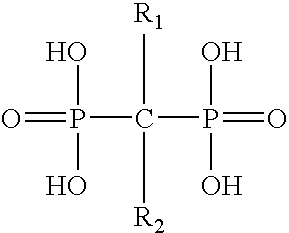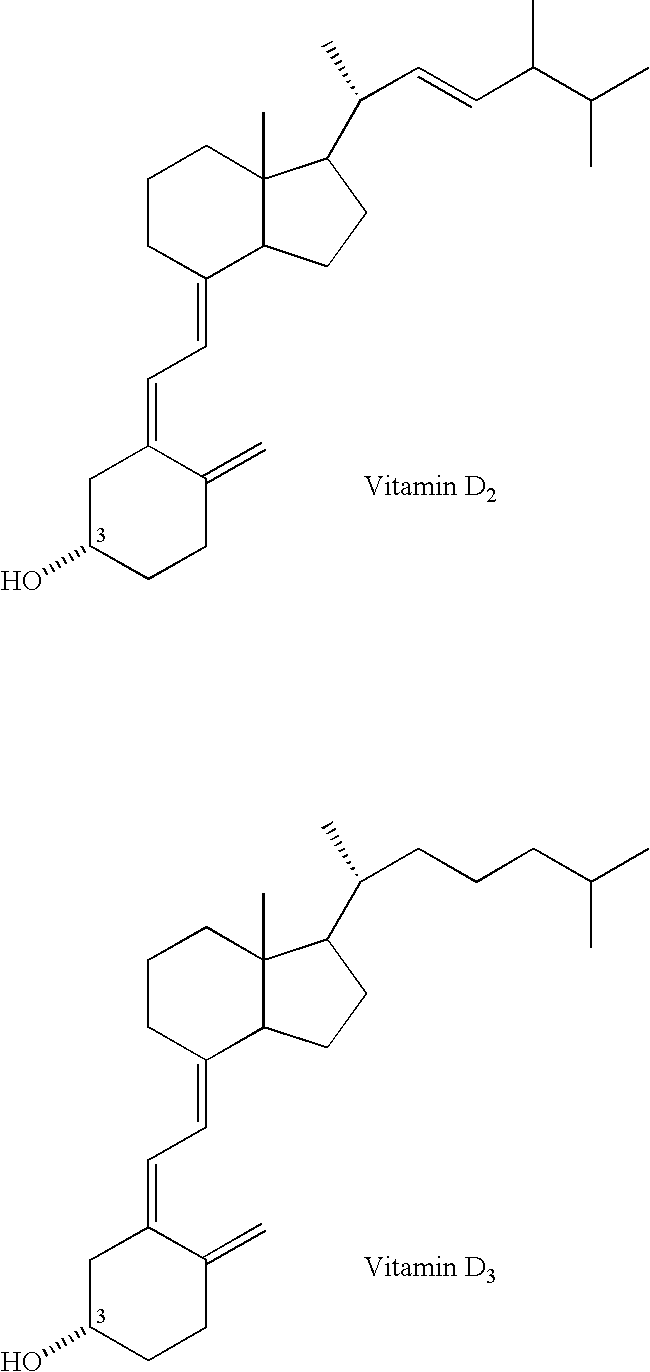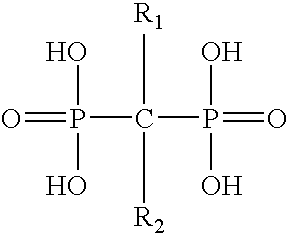Method for inhibiting bone resorption with an alendronate and vitamin d formulation
a technology of alendronate and vitamin d, which is applied in the direction of drug compositions, phosphorous compound active ingredients, metabolic disorders, etc., can solve the problems of reducing bone mineralization, affecting bone mineralization, and affecting bone mineralization, so as to inhibit abnormal bone resorption
- Summary
- Abstract
- Description
- Claims
- Application Information
AI Technical Summary
Problems solved by technology
Method used
Image
Examples
example 1
Effect of Vitamin D3 on Alendronate Absorption
[0122] To examine the potential for an interaction between alendronate and vitamin D3 metabolite administered orally, fourteen healthy adult subjects (6 men, 8 women, ages 33-61 yr.) were administered single 70-mg tablets of alendronate alone and together with a powdered dose of vitamin D3 metabolite (5600 IU) suspended in 240 mL of water. This study was of an open, randomized, crossover two-way design. The purpose of the study was to obtain a preliminary estimate of the relative bioavailability of alendronate following a 70-mg tablet administered with vitamin D3 metabolite, relative to alendronate administered alone.
[0123] Alendronate was administered orally as the 70-mg tablet in each of the 2 periods. In 1 period, the tablet was administered with vitamin D3 metabolite powder reconstituted in plain tap water and in the alternate period the tablet was taken alone with plain tap water. Urine was collected for two hours preceding and 36...
example 2
Once-Weekly Dosing Regimen
Treatment of Osteoporosis.
[0126] Alendronate and vitamin D3 metabolites tablets, liquid and effervescent formulations, and effervescent-buffered formulations containing about 70 mg of alendronate, on an alendronic acid active weight basis, and about 5,600 IU of vitamin D3 metabolites are prepared (see Examples 4 and 5). The tablets or liquid formulations are orally administered to a subject once-weekly, i.e. preferably about once every seven days (for example, every Sunday), for a period of at least one-year. This method of administration is useful and convenient for treating osteoporosis while providing vitamin D nutrition. This method is also useful for improving subject acceptance and compliance, and ensuring that all subjects taking a bisphosphonate receive supplemental vitamin D nutrition.
Prevention of Osteoporosis
[0127] Alendronate and vitamin D3 metabolite tablets or liquid formulations containing about 35 mg to about 70 mg of alendronate, on a...
example 3
Alendronate and Vitamin D3 Metabolite Tablets or Liquid Formulations
[0131] In further embodiments, alendronate and vitamin D3 metabolite tablets or liquid formulations are orally dosed, at the desired dosage, according to the dosing schedule of Example 2, for treating or preventing other disorders associated with abnormal bone resorption.
PUM
| Property | Measurement | Unit |
|---|---|---|
| active weight | aaaaa | aaaaa |
| active weight | aaaaa | aaaaa |
| body weight | aaaaa | aaaaa |
Abstract
Description
Claims
Application Information
 Login to View More
Login to View More - R&D
- Intellectual Property
- Life Sciences
- Materials
- Tech Scout
- Unparalleled Data Quality
- Higher Quality Content
- 60% Fewer Hallucinations
Browse by: Latest US Patents, China's latest patents, Technical Efficacy Thesaurus, Application Domain, Technology Topic, Popular Technical Reports.
© 2025 PatSnap. All rights reserved.Legal|Privacy policy|Modern Slavery Act Transparency Statement|Sitemap|About US| Contact US: help@patsnap.com



